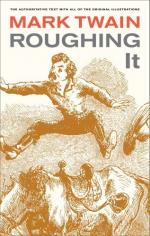The Secretary and I took quarters in the “ranch” of a worthy French lady by the name of Bridget O’Flannigan, a camp follower of his Excellency the Governor. She had known him in his prosperity as commander-in-chief of the Metropolitan Police of New York, and she would not desert him in his adversity as Governor of Nevada.
Our room was on the lower floor, facing the plaza, and when we had got our bed, a small table, two chairs, the government fire-proof safe, and the Unabridged Dictionary into it, there was still room enough left for a visitor—may be two, but not without straining the walls. But the walls could stand it—at least the partitions could, for they consisted simply of one thickness of white “cotton domestic” stretched from corner to corner of the room. This was the rule in Carson—any other kind of partition was the rare exception. And if you stood in a dark room and your neighbors in the next had lights, the shadows on your canvas told queer secrets sometimes! Very often these partitions were made of old flour sacks basted together; and then the difference between the common herd and the aristocracy was, that the common herd had unornamented sacks, while the walls of the aristocrat were overpowering with rudimental fresco—i.e., red and blue mill brands on the flour sacks.
Occasionally, also, the better classes embellished their canvas by pasting pictures from Harper’s Weekly on them. In many cases, too, the wealthy and the cultured rose to spittoons and other evidences of a sumptuous and luxurious taste. [Washoe people take a joke so hard that I must explain that the above description was only the rule; there were many honorable exceptions in Carson—plastered ceilings and houses that had considerable furniture in them.—M. T.]
We had a carpet and a genuine queen’s-ware washbowl. Consequently we were hated without reserve by the other tenants of the O’Flannigan “ranch.” When we added a painted oilcloth window curtain, we simply took our lives into our own hands. To prevent bloodshed I removed up stairs and took up quarters with the untitled plebeians in one of the fourteen white pine cot-bedsteads that stood in two long ranks in the one sole room of which the second story consisted.
It was a jolly company, the fourteen. They were principally voluntary camp-followers of the Governor, who had joined his retinue by their own election at New York and San Francisco and came along, feeling that in the scuffle for little territorial crumbs and offices they could not make their condition more precarious than it was, and might reasonably expect to make it better. They were popularly known as the “Irish Brigade,” though there were only four or five Irishmen among all the Governor’s retainers.
His good-natured Excellency was much annoyed at the gossip his henchmen created—especially when there arose a rumor that they were paid assassins of his, brought along to quietly reduce the democratic vote when desirable!




